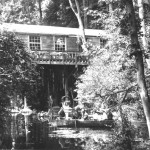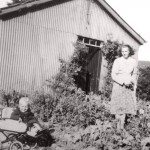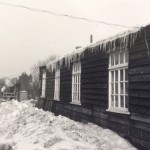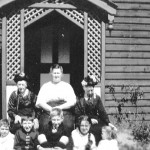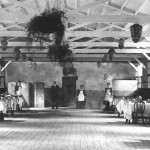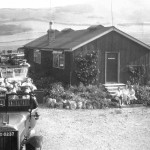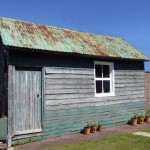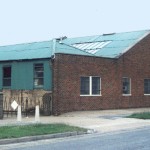During the First World War Royal Naval Airships were deployed at Polegate. After the war the buildings of this base began to find new and different uses.
The Polegate Royal Naval Airship Station at Lower Willingdon was disbanded on 6 February 1920 and handed to the Disposal Board the following June. An auction of the remaining buildings, stores and equipment took place between 3-5 of August that year. A number of buildings were bought and remained in position to be re used for various purposes. Whilst most were removed, some were to have another lease of life locally.
The large motor transport garage workshop was sold to George Morrish, whose land had been requisitioned in 1914 for part of the airship station. He used this very sizeable building for housing chickens for egg production until the mid 1930s, when he sold the surrounding land for housing development. Major Bird of the Eastbourne Aviation Company then purchased the building and it became ‘Birds Engineering’, a specialist Pneumatic Engineering firm. During WW2 the air raid siren was housed here. In the 1960s the corrugated iron front was replaced by one of brick, the original corrugated iron roof, sides and rear remained. In 1995 the firm closed and the eighty-year-old building was eventually demolished and a number of small bungalows built on the site and named Scanlan Close.
At the rear of the motor transport workshop were several smaller buildings some wooden, others corrugated iron. One such wooden building became the Willingdon Public Library. This same building was also used for ARP training, weekly dances and a baby clinic during WW2. Another similar building was utilised as the Willingdon Rifle Club. In June 1963 a modern library was built beside Birds Engineering Works but the old Library hut survived until 1995 used by the works.
Behind the old wooden Library stood one of the corrugated iron buildings converted into a bungalow for ex-servicemen. The Phillips family lived here from approx 1952- 1956.
One of the wooden buildings at the airship station entrance, was also bought by George Morrish who converted it to a bungalow for his family and lived there for a few years until building a family home ‘St George’s’ in Wannock Lane. He continued to rent out this bungalow until the Coppice estate was built around 1935 when it was demolished.
Two buildings were moved to the Wannock Area. One was purchased by James Gregg owner of the Wannock Fruit and Tea Gardens and erected in the centre of the charabanc park. It was used until 1970 as the bungalow for the car park attendant and his family, surrounded by attractive flowerbeds.
One of largest buildings was transported to Wannock Glen on the Jevington Road where it was supported on pillars and spanned the millstream, which flowed from Filching through Wannock powering the two water mills. This became the Wannock Glen Tea and Dance Hall. Verandas were built around the sides overhanging the stream, which was partially dammed for use with rowing boats. Inside live music was provided by a piano or quartet. This was a very popular destination for charabanc outings from Eastbourne and the surrounding area. For the evening dances the Pavilion was lit by Chinese lanterns as were the little rowing boats and lanterns on the verandas reflected in the water below making an enchanting setting on warm summer evenings. This venture only survived into the 1930s.
Just one building is known to survive in 2015 still in use in the garden of ‘St George’s’ Wannock Lane the former Morrish home, where it was moved in the 1920s. It was the Paymaster’s Office, which originally stood beside the old motor transport workshop. For many years it was used as an apple store but now 100 years on it is just a garden shed but a garden shed with rather a unique history.
- Wannock Glen Tea and Dance Pavillion – Image courtesy of Rosalind Hodges
- Phillips family home – Image courtesy of Rosalind Hodges
- Old Willingdon Library hut – Image courtesy of Rosalind Hodges
- Morrish Family bungalow c.1922 – Image courtesy of Rosalind Hodges
- Glen Tea Pavilion interior – Image courtesy of Rosalind Hodges
- Former RNAS hut Wannock Gardens – Image courtesy of Rosalind Hodges
- Former Paymaster’s Office – Image courtesy of Rosalind Hodges
- Birds Engineering works former RNAS motor transport workshop – Image courtesy of Rosalind Hodges
This story was submitted by Rosalind Hodge, Archivist, Willingdon Parish Church


